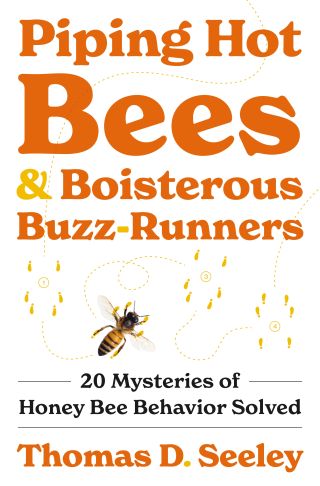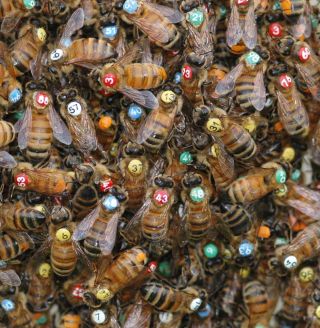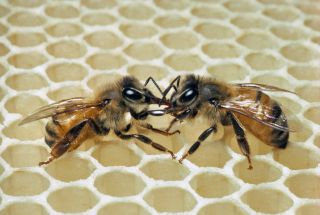Animal Behavior
The Swarm Intelligence of Piping Hot and Boisterous Honey Bees
Thomas Seeley's new book is a wonderful read about these fascinating insects.
Posted April 9, 2024 Reviewed by Michelle Quirk
Key points
- In his book, he discusses the social physiology and collective intelligence of honey bee colonies.
- Worker honey bees are probably the most intelligent insects on the planet.
- Worker honey bees are our most important pollinators, and a worker honey bee dies when it uses its sting.

Bees are fascinating intelligent and sentient insects whose cognitive and emotional lives are currently receiving the attention they have long deserved from serious card-carrying scientists.1 I always want to learn more about research on these mysterious beings, and when Cornell University's Thomas D. Seeley's new book with the eye-catching title Piping Hot Bees & Boisterous Buzz-Runners: 20 Mysteries of Honey Bee Behavior Solved appeared in the mail, I immediately sat down and was enthralled on just about each every page. In his groundbreaking book, Seeley "weaves illuminating personal stories with the latest science, explaining such mysteries as how worker bees function as scouts to choose a home site for their colony, furnish their home with beeswax combs, and stock it with brood and food while keeping tens of thousands of colony inhabitants warm and defended from intruders." Here's what he had to say about these amazing small-brained insects.
Marc Bekoff: Why did you write this book, and how does it relate to your background and general areas of interest?
Thomas Seeley: I wrote this book to provide a personal, first-person account of my studies of the behavior and social life of honey bees. These are my favorite insects, and I have investigated their lives for more than 50 years. A scientist is expected to report his/her discoveries with fellow scientists by writing detailed articles that are published in scientific journals, and I have written more than 200 such articles. While publishing these formal reports, though, I often felt that what I had learned about the lives of honey bees should be shared with nonscientists, too, and especially with beekeepers. So, in the mid-1990s I began to write books in which I describe the nifty things that I and others have learned about the lives of these bees. I used to think that I had written these books in a way that works for general readers, but now I see that these books were still too scientific for most nonscientists.

When I retired, in 2022, I decided to write a book of short stories, arranged chronologically, in which I describe in plain language how my colleagues and I solved various mysteries about honey bee behavior. This book is not a complete summing up—my case list of mysteries solved has 37 lines of investigation—but it does comprise 20 stories that fit together well and don't exceed the word limit that the publisher specified.
MB: Who do you hope to reach with your book?
TS: First and foremost, I hope to reach beekeepers. These are people who are deeply curious about how honey bees behave but rarely get good information about this subject. This is because the craft of beekeeping deals mainly with manipulating whole colonies of honey bees rather than watching individual bees. So, the books on beekeeping provide beekeepers with rather little information about how individual bees behave.
I hope, too, that my book will be a valuable read for behavioral biologists who investigate insect cognition by studying honey bees. Worker honey bees are probably the most intelligent insects on the planet. A distinguished British entomologist, Sir Vincent B. Wigglesworth, made this point nicely when he wrote, "The honey-bee is as far above the general run of other insects as man is above all his fellow mammals. The complexity of the social life of bees, their powers of mutual communication, their diversity in skills and employment, their debates and decisions on policy, are so remarkable that they raise the question of the capacity of the bee for thinking." Readers of my new book will find it easy to agree with this statement.
My primary hope, though, is that my book will spark a passion in some young biologists to explore further the countless mysteries of honey bee behavior. My work consists of carefully describing the communication behaviors of worker bees and then investigating what elicits these behaviors and how they contribute to the functioning of a colony. There is so, so much more to discover.
MB: What are some of the major topics that you consider?
TS: The general subject that I discuss in my book is the "social physiology" of honey bee colonies. In other words, I discuss how the 25,000 or so worker bees in a colony work together to choose a snug tree cavity for their home, furnish it with combs made of beeswax, fill these combs with food, and keep their home suitably ventilated, comfortably warm, and well defended. Each of these aspects of proper colony functioning depends on its worker bees doing the right things, just as the proper functioning of a human's body depends on its cells doing the right things.

Readers of my book will learn about the most impressive form of democratic decision-making there is outside the realm of human affairs. This process takes place when a colony casts a swarm to start a new colony. A swarm consists of a colony's queen and some 12,000 of its worker bees that leave their old home en masse, and eventually move into a new home site. The members of a swarm face the problem of finding a suitably sized and protective nest cavity. I explain that their search for good housing entails several hundred of the elderly worker bees (the nest-site scouts) in a swarm conducting a plebiscite to choose which one of a dozen or more possible nest cavities is the best.
MB: How does your book differ from others that are concerned with some of the same general topics?
TS: There are two ways in which my book differs from most books on animal behavior. The first is that each chapter is a discussion of a specific behavior in a single species (Apis mellifera) rather than a general category of behavior that applies across many species. The second is that I have made each chapter a personal story, not an impersonal discussion, of studying a particular aspect of honey bee behavior.

MB: Are you hopeful that as people learn more about who these amazing insects truly are they will be more open to developing and maintaining a co-existence that is a win-win for honey bees and human beings?
TS: Yes, for sure. For example, people will learn that worker honey bees are our most important pollinators and that a worker honey bee dies when it uses its sting, so these bees are careful about using their stings. They do not fly out of their homes and sting people willy-nilly.
References
In conversation with Dr. Thomas D. Seeley, Horace White professor in biology emeritus at Cornell University. His scientific work focuses on understanding the phenomenon of swarm intelligence: the solving of cognitive problems by a group of individuals who pool their knowledge and process it through social interactions. His work is summarized in three books: The Wisdom of the Hive, Honeybee Democracy, and The Lives of Bees.
1. The Fascinating Minds and Personalities of Bees; The Mind-Blowing Lives of Amazing Bees; Bumble Bees Play With Balls and May Even Enjoy It; The Fascinating Complex Minds of Bees and Why They Matter; Happy Bees: Bumblebees Show Dopamine-Based Positive Emotions; The Birds and the Bees and Their Brains: Size Doesn't Matter.




